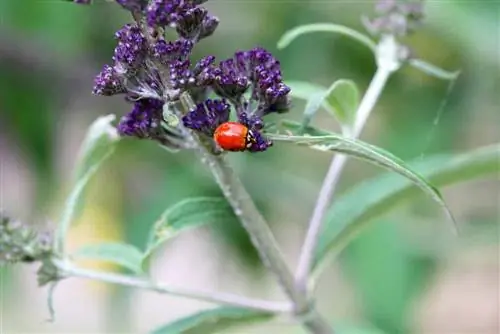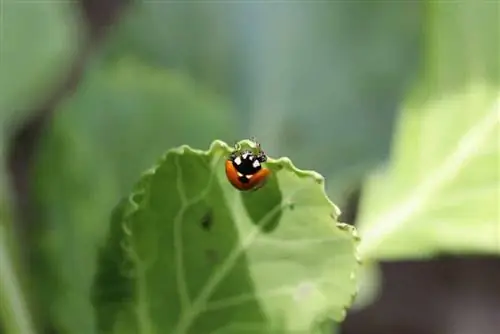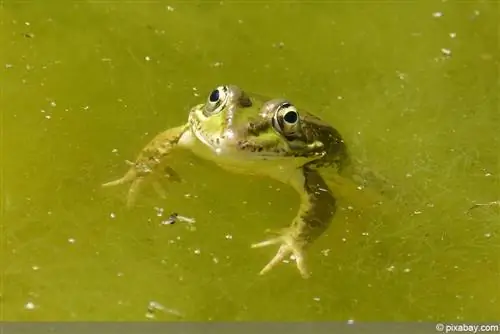- Author admin [email protected].
- Public 2023-12-17 03:39.
- Last modified 2025-01-24 12:45.
Some of the different species of ladybirds are bred specifically to combat pests in nature, which is why they represent a very important link in the ecosystem. Like many other animals in Western Europe, they mostly overwinter here. How and where this occurs depends primarily on the species, although all, with a few exceptions, hibernate to cope with the cold temperatures. They can also help to significantly increase the chances of survival. Below you will find out all the information you need to know.
Wintering
The native beetles such as the most common seven-spot ladybird (Coccinella septempunctata) spend the winter in Western Europe. Just like the Asian Harmonia axyridis, which is slowly replacing the “lucky beetle” in number.
Type 1
The ladybird species that overwinter in these areas use the last sunny days in early autumn to look for suitable winter quarters. There they fall into hibernation at certain ambient temperatures.
Type 2
Other species prefer to migrate from Western Europe. Depending on the species and bodily function, they move north or south. The few beetles that migrate north require more constant winter temperatures to overwinter because they go into hibernation. This includes, for example, thetwo-spotted beetle It could also overwinter in Western Europe, but there it would run the risk of waking up due to sometimes warmer outside temperatures and unnecessarily burning energy from the fat deposits it has created. Every awakening would bring him closer to starvation, especially in long winters.
Type 3
Species of beetles whose bodies do not react to cold temperatures and would therefore die of frostbite are moving towards the south.
Hibernation/hibernation
hibernation
In Germany and all other colder winter regions in Europe, hibernation is the most common type of overwintering among ladybirds. From around 12 degrees Celsius, the heartbeat and breathing of cold-blooded animals slow down, and the body temperature slowly drops to around five degrees Celsius. The latter basically happens in adaptation to the existing ambient temperature.
Winter torpor
When outside temperatures fall below 0 degrees Celsius or even lower on cold winter days, some ladyworms, as the beetle is also known colloquially, go into hibernation. Here the body temperature drops again and remains at around 0 degrees Celsius. Now all vital organ functions only run on a “low flame” and amount to between three and five percent, in contrast to an active beetle in the summer months.
The Asian ladybird, for example, can survive sub-zero temperatures of up to ten or 15 degrees Celsius in this way.
Body heat
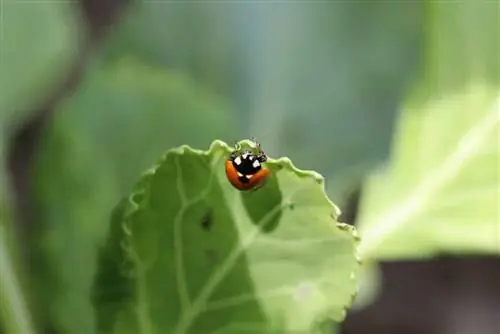
The ladyworms, which do not fall into hibernation, are warmed by previously eaten fat deposits and are also protected from icy sub-zero temperatures in their winter quarters, which they explicitly choose for precisely this reason. Basically, ladybugs gather to spend time together in hibernation or hibernation and warm each other because they move close together.
Hiking trains
Beetle genera that travel to distant countries to overwinter usually set off in late summer. You can see them flying towards shores in flocks. But mostly the small flying animals that had settled not far from the coasts set off. To determine direction, they rely on the climatic conditions.
Since they only have small wings and a light body weight, the wind is their greatest enemy in the air. So it always happens that they end up in between. Large concentrations of ladybirds can often be seen in late summer and early fall, especially in coastal areas. There they may then wait for the wind and possibly rain conditions to improve so that they can fly safely over the sea towards their wintering location. However, they also owe the ability to fly such long distances to the wind because they can be carried and propelled by it.
The migratory flight is not always successful, which is why in autumn numerous ladybirds swim in from the sea that did not make it. Those who have survived and can live for several years usually take the return flight to Europe in the following early spring.
Food
As soon as the ambient temperatures reach winter levels and the Coccinella falls into hibernation or hibernation, it hibernates largely without eating. He draws the energy he needs for the slowed down bodily functions from the full fat depots that he has accumulated by late summer/beginning of autumn. As a rule, these are large enough to survive the winter without starving.
Starvation death
It only becomes dangerous for the beetles when they wake up from their hibernation form more often due to high temperature fluctuations and/or the cold winter temperatures drag on for a long time. In these cases, some animals starve to death at this time of year. Only when temperatures rise to at least eight degrees Celsius over a longer period of several days or even weeks do the ladybirds break their hibernation and go looking for food.
Then they can also be found in apartments, where, for example, they look for aphids in the plant pots or go hunting for mites elsewhere. However, since many food sources disappear in winter, long interruptions in hibernation are not beneficial.
If the temperatures drop again, they hide again in suitable winter quarters and fall into hibernation or hibernation again until spring.
Tip:
During the hibernation phase, you should not disturb the Coccinellas in their sleep or rigidity, nor should you move them to a warmer environment. This could cost them their lives if it causes them to expend more energy and be able to eat little to no food.
Winter quarters

The ladybird species in Western Europe mostly overwinter protected from cold and predators in a wide variety of places. In this search for a suitable winter quarters, they usually go in larger groups with other animals. One of the advantages of this is that after overwintering they don't have to look for a partner to reproduce with, but can find one in the group. In this way they save a lot of time and can have offspring twice a year thanks to early fertilization. The beetle genus usually prefers winter quarters that are moist and offer protection from the wind.
That's why they usually spend the winter:
- in piles of leaves
- under layers of moss
- in tree hollows
- in cracks in tree bark
- under stones
- in taller grass
But even where heat is radiated, they prepare for the winter. For example, they use residential buildings where they choose gaps in the masonry and windows or window frames as their quarters for the winter. However, they usually only move into these places when they wake up from their hibernation form due to temperature fluctuations and the cold suddenly surprises them again. Then there is often not enough time to find a more suitable place to overwinter and they then instinctively move towards warmth.
Home winterization
Warm temperatures attract active ladybugs in winter. It doesn't matter whether they have woken up from hibernation or whether the cold temperatures are still a long way off, but the insects have already settled into winter storage and are then drawn outside again. It often happens that the beetles get lost in the living space or specifically look for food there.
However, warm living space is not a good option for them, because every degree of heat reduces their chance of survival this time of year. The winter season offers little to no food supply, meaning ladybugs could miss out on their hibernation. It is therefore important that they are exposed to the cold again so that they can overwinter in their natural form without the need for nutrition. If you don't voluntarily go outside or can't find it, you should definitely help.
Expose
Even if it sounds harsh, the most effective way to get lucky beetles and their fellow beetles outside is with a vacuum cleaner.
This can be intelligently prepared so that no injuries are caused to the beetles:
- A sock with elastic cuffs is required
- Put the cuff over the suction tube
- Push the remaining sock into the suction tube
- The tip of the sock should form the rearmost end in the suction tube
If you discover ladybugs in your living room or elsewhere in places that are too warm, simply suck them up in one go using the sock on the suction tube. It is important that you choose the lowest suction power. Before you turn off the vacuum cleaner, remove the sock cuff from the suction tube and close the sock with your hand.
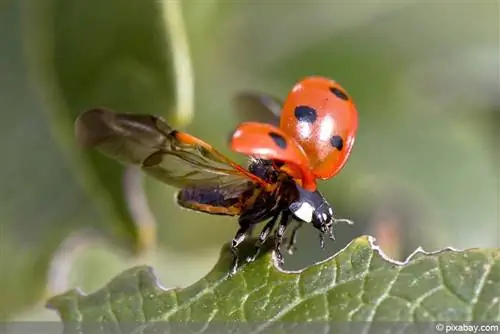
If you now turn off the vacuum cleaner, you can easily pull the sock out of the inside of the suction tube, transport the beetles outside and carefully shake them out of the sock in a suitable place, such as a pile of leaves.
Wintering aid
In order to be able to offer ladybirds more places to overwinter, a wintering aid is particularly suitable in apartment buildings where you do not have a garden. This can easily be done yourself. Simply take a wooden box that is at least ten centimeters long and wide and has an opening lid. Drill a hole of approximately 0.8 centimeters into the box.
On the top, you should attach a water barrier, such as a piece of roofing felt. You can line the interior with wood wool and/or autumn leaves. Place the overwintering box on a wooden stick and put it in a balcony box or plant pot. This is where the ladybugs are most likely to find it. When painted, the winter quarters also look decorative.
Conclusion
Ladybirds usually survive the winter in hibernation or hibernation when the ambient temperatures drop too much into the minus range. You don't have to eat any food during this time, as fat stores normally cover the low energy requirements for the entire winter season. Only a few species of ladybirds make their way to other climatic regions and overwinter there. To minimize the risk of Coccinella mortality, you can do your part. Do not disturb the animals during the winter phase and with just a few simple steps you can even provide suitable winter quarters.

